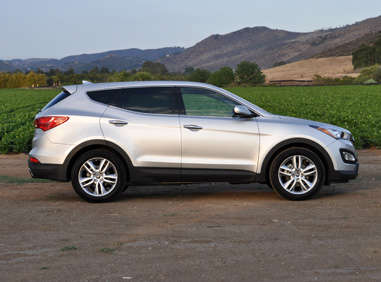Recent Articles
Popular Makes
Body Types
2013 Hyundai Santa Fe Sport Road Test and Review

If you seek historical evidence of Hyundai’s massive leaps forward in terms of design, engineering, packaging, and technology, look no further than the Santa Fe crossover SUV. Launched for the 2001 model year and taking the form of an overweight, misshapen, garishly decorated compact SUV, the Santa Fe morphed into an appealing and attractive, if somewhat conservative, crossover that provided all the passenger and cargo space a family of four might reasonably require. Now, the 2013 Hyundai Santa Fe is redesigned one more time, marking the next design frontier for the automaker.
Dubbed “Storm Edge,” which might as well describe the automotive industry sales threat that has been approaching from the Korean peninsula for more than a decade, Hyundai’s newest styling themes are reflected in the new 5-passenger Santa Fe Sport, which replaces the previous Santa Fe, and the new 7-passenger Santa Fe, which replaces the previous Hyundai Veracruz. The Santa Fe Sport is still sized as a “tweener,” one that competes with a range of compact and midsize 5-passenger crossovers like the Ford Escape and Ford Edge, or the Nissan Rogue and Nissan Murano; while the larger Santa Fe goes head-to-head with midsize models such as the Ford Explorer, Honda Pilot, Toyota Highlander, and others.
In addition to the two-pronged model lineup and the new exterior designs, the 2013 Santa Fe offers new powertrains, new technologies, and many more features that can push prices far beyond previous levels. To find out how well this new crossover serves as a family schlepper, I borrowed a Santa Fe Sport 2.0T with all the trimmings, installed the child safety seats, loaded up the stroller, and almost had a heart attack over the price tag.
2013 Hyundai Santa Fe Sport Road Test and Review: Models and Prices
It’s a mental thing. Nobody expects a 5-passenger crossover with a Hyundai badge to wear a window sticker with a price tag closer to $40,000 than $30,000. Despite my initial reaction to my test vehicle’s price tag, the Santa Fe Sport still represents a reasonable value, and it simply isn’t fair to expect Hyundai to continue to provide an arguably superior product at a discount. That’s akin to believing that women should be paid less than men for the same job.
Besides, nobody says you need to get the most expensive version of the Santa Fe Sport. Choose one with front-wheel drive and the standard 2.4-liter 4-cylinder engine, and the price is $25,555 before negotiating with the dealer (including a destination charge of $855). And that’s not a stripped-down vehicle, either. If you can live without all-wheel drive, you save $1,750. If you can live without the much more powerful turbocharged engine option, you save another $3,250. Equip this base model with leather, navigation, premium sound, heated power-adjustable front seats, a reversing camera, keyless entry with push-button ignition, and a panoramic sunroof, and you remain well within reason at $32,155.
My test model was the Santa Fe Sport 2.0T with AWD and an opening price of $30,555. In addition to the turbocharged engine and AWD, this model includes larger 19-inch aluminum wheels, keyless entry and push-button ignition, a power driver’s seat, heated front seats, electroluminescent gauges, heated side mirrors, automatic headlights, and fog lights. To this, my Moonstone Silver test vehicle added the Technology Package as well as the Leather and Premium Package, plus carpeted floor mats, a cargo cover, and a cargo net, bringing the as-tested total to $36,240.
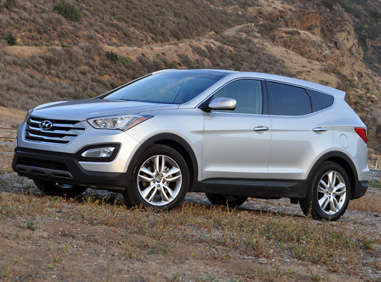
2013 Hyundai Santa Fe Sport Road Test and Review: Design
- Completely redesigned, inside and out
- 5-passenger Santa Fe Sport and 7-passenger Santa Fe models
One of the problems with selling the Santa Fe Sport at a price north of $35,000 is that the quality of the interior comes under extra scrutiny, and it is here that owners might feel like they overpaid for this Hyundai. The Santa Fe’s interior design and layout is bafflingly busy, employing multiple textures, tones, and colors perhaps in an effort to create a visual distraction from certain inexpensive materials, such as the hard plastic on the lower half of the dashboard, door panels, and on the center console. The leather seat perforations only add to the clutter, rendered in a clustered rather than uniform pattern.
The Santa Fe Sport’s exterior, however, looks terrific, especially with the larger 19-inch wheels on our 2.0T AWD test vehicle. Often, car companies seeking a distinctive appearance create designs that are unmistakable, and simultaneously unappealing. Other automakers force designers to work around engineering and packaging priorities, effectively making it difficult to craft pleasing exterior aesthetics. With regard to the Santa Fe Sport, Hyundai had no trouble wrapping its new crossover in good-looking sheetmetal. The styling alone ought to sell plenty of these SUVs.
Parents will want to note, however, that the Santa Fe Sport’s sexy upswept side glass limits visibility for smaller children riding in the back seat, and that the tiny rear quarter glass severely limits visibility when reversing from angled parking spaces. The optional reversing camera doesn’t help much when it comes to showing what might be approaching the SUV from the sides, either.
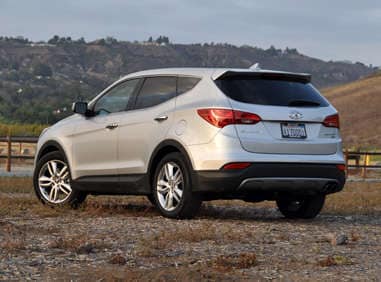
2013 Hyundai Santa Fe Sport Road Test and Review: Comfort and Cargo
- Optional heated front and rear seats
- Optional heated steering wheel
Though the Santa Fe Sport is the shorter of the two new 2013 Santa Fe models, it offers plenty of space for a family of four. However, even our well-equipped test vehicle suffered a comfort problem frustratingly common not just in Hyundai models, but also in most mainstream vehicles.
The issue has nothing to do with the driver’s seat, which is comfortable and supportive. The upper door panel and center console lid are padded for added comfort, and the range of power adjustments provide a good driving position in combination with a tilt/telescopic steering wheel that is wrapped in smooth leather, offers thumb rests, and is pleasing to grip.
Rather, the comfort complaint pertains to the front passenger’s seat, which in our test vehicle offered 4-way power adjustment but lacked a height adjuster. As a result, the front passenger sits low and close to the floor.
Thankfully, the rear seat cushion sits high enough, and is angled enough, so that adults are comfortable and benefit from decent thigh support. The front seatback covers are hard plastic, but they’re scooped out to provide plenty of legroom, and this crossover provides lots of foot space under the front seats. The rear seatbacks also recline for napping.
Standard equipment includes Yes Essentials cloth upholstery, a stain-resistant material that also contains an antibacterial component designed to control cabin odors. Our test vehicle had the optional leather seats, which, after 7,500 miles, were beginning to show some age on the outer bottom cushion bolsters.
The Santa Fe Sport’s cargo area measures a generous 35.4 cu.-ft., and the optional cargo cover looks and feels substantial, almost Germanic in terms of its design and heft. Compartmentalized bins underneath the cargo area offer additional storage, and the back seats fold down to create 71.5 cu.-ft. of cargo space. The rear liftgate is light in terms of weight, has a thick hand grip to use for closing, and is easy to shut.
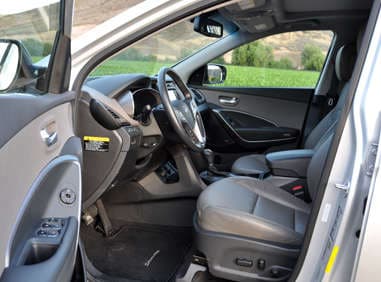
2013 Hyundai Santa Fe Sport Road Test and Review: Features and Controls
- Blue Link telematics with various information services
- Standard Bluetooth with audio streaming capability
- Optional panoramic sunroof, premium Dimension audio system
If the Santa Fe Sport’s interior looks busy, the clearly labeled controls and razor sharp graphics help to make up for it. Most of the knobs and buttons are large, easy to use, and located where the driver expects to find them. The handful that are not, such as the fuel door release on the leading edge of the driver’s door panel armrest, quickly become second nature to any owner.
My test car had the Santa Fe’s optional Technology Package with an infotainment system and an 8-inch color touchscreen embedded into the dashboard. I am a big fan of this system’s high-resolution graphics, intuitive touchscreen icons, and primary function hard keys. Overall, the presentation is clean and upscale, descriptors that also apply to the Santa Fe Sport’s available electroluminescent gauges and information display.
Every 2013 Hyundai Santa Fe Sport is equipped with standard Blue Link technology, a telematics system offering a wide range of features. Blue Link can be accessed via a paired smartphone, buttons located on the rearview mirror housing, or remotely using a computer, and Hyundai provides a limited-time subscription to all Blue Link services to all Santa Fe Sport buyers.
Additionally, Hyundai recently announced that Blue Link-equipped models include three years of free Assurance Connected Care service that includes vehicle diagnostic reports, maintenance alerts, recall notifications, and a suite of safety-related services that are discussed in the next section.
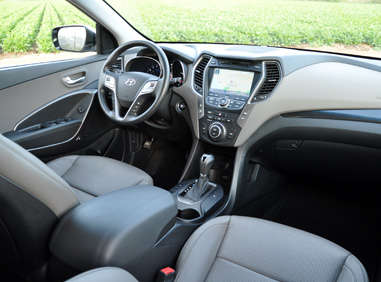
2013 Hyundai Santa Fe Sport Road Test and Review: Safety and Ratings
- Blue Link telematics with Speed Alert, Curfew Alert, and geo-fencing capabilities
- Free 3-year subscription to Assurance Connected Care
- Optional reversing camera
As a part of the Hyundai Assurance Connected Care program, which is free for the first three years of vehicle ownership, every Santa Fe Sport includes Automatic Collision Notification service. If the SUV’s airbags deploy, a Blue Link response specialist will connect to the vehicle, check on the occupants, and dispatch 911 emergency rescue personnel to the Santa Fe Sport’s exact location in order to speed rescue. Additionally, the Blue Link operator will remain connected to the vehicle, and the people inside, until help arrives.
In addition to Automatic Collision Notification, the Assurance Connected Care program includes a driver-activated SOS Emergency Assistance feature, as well as a direct connection to Hyundai’s roadside assistance program. The Santa Fe Sport also comes standard with seven airbags, hill-start assist control, and downhill brake control. A reversing camera is optional.
The new Santa Fe Sport receives top-notch crash-test ratings. The National Highway Traffic Safety Administration (NHTSA) gives the SUV an overall rating of 5 stars, while the Insurance Institute for Highway Safety (IIHS) calls the Santa Fe Sport a “Top Safety Pick.”
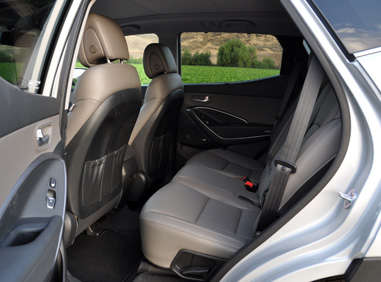
2013 Hyundai Santa Fe Sport Road Test and Review: Engines and Fuel Economy
- Standard 2.4-liter 4-cylinder engine
- Optional turbocharged 2.0-liter 4-cylinder engine
- Optional Active Cornering Control AWD system
- Active Eco powertrain setting to improve fuel economy
When choosing a Santa Fe Sport, buyers select between a standard model equipped with a 2.4-liter 4-cylinder engine and a 2.0T model powered by a turbocharged 2.0-liter 4-cylinder engine.
The standard 2.4-liter engine generates 190 horsepower at 6,300 rpm and 181 lb.-ft. of torque at 4,250 rpm, and is rated to get between 20 mpg in the city and 29 mpg on the highway, depending on whether or not it is paired with the optional all-wheel-drive system.
Compare that to the turbocharged engine, which is rated to make 264 horsepower at 6,000 rpm and 269 lb.-ft. of torque between 1,750 rpm and 3,000 rpm. Fuel economy ratings for this engine range from 19 mpg in the city to 27 mpg on the highway, with the AWD model expected to average 21 mpg in combined driving.
My family missed that mark by a full 3 miles per gallon, averaging 18 mpg during a week behind the wheel. While our driving was primarily concentrated in city and suburban environments, we did keep the SUV’s Eco powertrain mode engaged the majority of the time. On a more positive note, the turbocharged engine doesn’t require premium fuel.
The Santa Fe Sport’s optional AWD system includes Active Cornering Control, a torque-vectoring system designed to help the Santa Fe Sport feel more responsive in corners. That it does, but as we’ll discuss in the next section, this crossover SUV isn’t quite as much fun to drive as its name might lead one to expect.
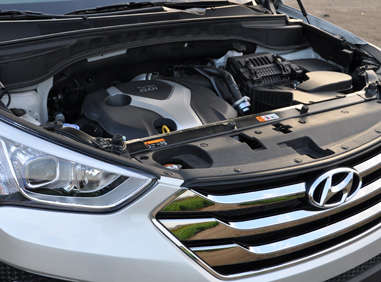
2013 Hyundai Santa Fe Sport Road Test and Review: Driving Impressions
Dynamically, the least satisfying aspect of driving the Hyundai Santa Fe Sport is its electric Driver Selectable Steering Mode system. Offering Comfort, Normal, and Sport settings, the only choice that felt natural enough that it didn’t serve as a constant irritant to the driver was Comfort mode. The Normal model is OK, but proves resistant to minor corrections just off center when driving down the highway in a straight line. The Sport mode is apparently calibrated to fight against driver input just off center, and feels loose and disconnected on center. In all settings, the steering feels artificial, almost like a video game. And crosswinds don’t help contribute to a sense of connectedness and stability.
Though we spent a disproportionate amount of time driving the Santa Fe in the city and in heavy traffic, this engine certainly likes to swill the regular unleaded. I really like the swell of torque this engine delivers, though. While there is no shortage of engine power, the Santa Fe Sport is not as quick as I expected. Also, note that a palpable difference exists between the Eco and regular powertrain modes in terms of responsiveness, and attempting to tackle the cut-and-thrust of urban city driving in Eco mode is not recommended. It was hot on the day we trudged into Los Angeles, and the Santa Fe Sport behaved in an undecided fashion when making left turns across heavy traffic and when making lane changes to skirt around motorists who were turning right or left from traffic lanes. Shutting the Eco mode off made the SUV feel much sprightlier in this environment.
From the driver’s seat, the Santa Fe Sport feels a little nose heavy, but this could just be an impression generated by the SUV’s broad and blunt nose. Sharper impacts from distressed pavement also filter right into the cabin, which adds to the “feeling” that there’s a bunch of mass over the front end.
In terms of suspension tuning, Hyundai appears to focus on ride quality despite this crossover’s “Sport” moniker. As a result, the Santa Fe Sport exhibits more body motion and roll in corners than I expected. To the SUV’s credit, the Santa Fe soaks up awful inner city pavement except for the biggest of cracks and holes. The tires also do a good job of providing grip and keeping quiet about it, unless you’re traveling on coarse pavement, and then the volume level of road roar is surprisingly loud.
One of my favorite things about driving the Santa Fe Sport is the braking system, which is operated using a pedal that feels natural underfoot and proves easy to modulate. On a hot testing day during a workout on a twisty downhill section of road, the brakes delivered consistent performance and did not fade.
Since my test vehicle had the optional AWD system, I took it on a trail that I use for crossovers to see how it might fare. To put it kindly, the Santa Fe Sport displays light off-road capability. Wheel articulation is adequate, but a shallow approach angle renders the front bumper and air dam susceptible to scraping and damage. The system offers a “4WD Lock” setting that evenly distributes power between the front and rear wheels to improve traction when necessary.
Overall, the Santa Fe Sport is capable if not quite entertaining to drive. This is a sporty crossover, but not a sport-tuned crossover.

2013 Hyundai Santa Fe Sport Road Test and Review: Final Thoughts
When it comes to affordable crossover SUVs, there is no shortage of choice. The 2013 Hyundai Santa Fe Sport pushes many of the right emotional buttons, from styling and size to safety and technology. Unfortunately, its few flaws are of the kind that can become daily sources of regret. The Santa Fe Sport should definitely be on your test-drive short list; just make sure you can live with mediocre gas mileage, the sloppy electric steering, the jarring interior design, and the low-mounted front passenger’s seat.

2013 Hyundai Santa Fe Sport Road Test and Review
- Great looks
- Roomy back seat
- Sizable cargo area
- Standard Yes Essentials cloth seats
- Powerful turbocharged engine
- Impressive ride and handling
- Top-notch crash-test ratings
- Assurance Connected Care services
- Terrific warranty
- Quaffs fuel
- Dissatisfying electric steering
- Lacks front passenger seat height adjustment
- Busy interior design with some low-rent materials
Hyundai supplied the vehicle for this review
2013 Hyundai Santa Fe 2.0T photos by Christian Wardlaw
